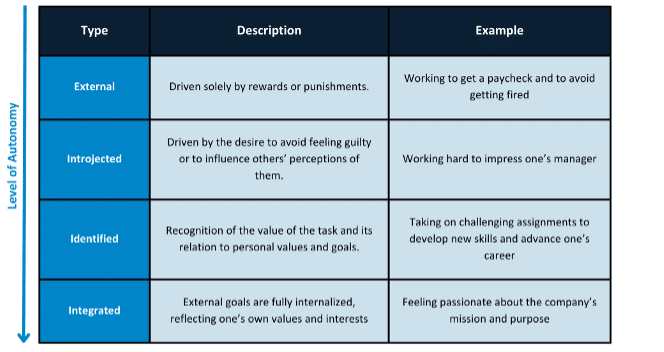Beyond the Carrot and Stick: The Truth Behind Motivation

Have you ever felt that spark, that inner drive that propels you toward a goal? That’s motivation – the invisible engine that fuels our actions, shapes our choices, and ultimately, determines our success. But the truth is, motivation isn’t a one-size-fits-all phenomenon. Depending on the person and the context, different factors may influence an individual’s drive to action. This blog is an invitation to delve deeper into motivation by reviewing three popular theories and perspectives. We’ll explore different facets of motivation and discover practical ways to cultivate and nurture it.
The Carrot and Stick Approach
For decades, managers have relied on the carrot-and-stick approach to motivate employees. This approach is a traditional motivational strategy that uses extrinsic (i.e., external to the individual) rewards and punishments to influence behavior. Dangle the promise of rewards for good performance (carrot) and tap into the fear of consequences for slacking (stick). It’s based on the idea that people are primarily driven by external factors, and by manipulating these factors, we can control their actions. Not only does this view have some serious ethical implications concerning free will, but it may also backfire. Kohn (1993) goes as far as to argue that rewards are just as undesirable as punishments in the long term, as individuals will eventually resent being manipulated, destroying the potential for true learning. To a less extreme degree—the carrot-and-stick approach prioritizes compliance over engagement, potentially leading to long-term disengagement.
It’s based on the idea that people are primarily driven by external factors, and by manipulating these factors, we can control their actions.
While research does suggest some benefits for extrinsic incentives in the short term, such as effectively getting people to complete tasks that are simple, highly repetitive, and/or uninteresting to the individual (Kuvaas et al., 2017), extrinsic motivation can be detrimental to innovation and creativity. For example, Glucksberg (1962) conducted a study in which participants were given a candle, matches, and a box of thumbtacks, and were tasked with attaching a lit candle to the wall without dripping wax. One group of participants were told they would receive a monetary reward for solving the problem quickly, while the other group was not offered a monetary reward and were simply told that they were pilot testing various problems. Interestingly, the “unmotivated” group solved the problem faster on average. Glucksberg (1962) suggested that external motivation leads to fixation, which might hinder the ability to think outside the box. As the workplace increasingly requires innovation and creativity, it would be wise to consider desired goals before utilizing extrinsic motivators.
Beyond Rewards and Punishments
Of course, motivating others does not strictly have to rely on extrinsic factors. Instead, individuals may be driven by intrinsic motivation, or the inherent satisfaction that comes from actions themselves. A popular approach to intrinsic motivation is Pink’s (2011) framework, which challenges the traditional approach by acknowledging that individuals are energized into action when they believe that their choices will lead them toward a desired outcome. Essentially, people are motivated when they feel like what they do matters. This is in stark contrast to the carrot-and-stick approach, which assumes that managers can control workers’ actions simply through managing their consequences.
Pink (2011) theorized one’s full potential can be realized by satisfying three core needs:
- Autonomy: The feeling of being in control and working in a way that we like.
- Mastery: The desire to become better at something that matters to you.
- Purpose: Finding meaning in being a part of something bigger than ourselves.
According to Pink (2011), those who are intrinsically motivated by their work through these three needs feel a true sense of enjoyment and will work toward goals even without external factors (e.g., pay raises, awards, perks). However, not all work is intrinsically motivating. While work environments that can satisfy the three core needs may be ideal, this isn’t always possible. This is not an excuse for organizations to ignore autonomy, mastery, and purpose. Organizations should explore different ways to engage their employees, providing opportunities for growth and connecting their actions to the bigger picture. Moreover, extrinsic motivation doesn’t just have to be about rewards and punishments. Ryan and Deci (2000) examine four types of extrinsic motivation, which reflect an increasing amount of autonomy:

The utilization of the external and introjected types of extrinsic motivation are seen as more controlling, while the identified and integrated types are seen as more autonomous. Unsurprisingly, the latter two are thought to result in better outcomes (such as job performance and job satisfaction; Ryan & Deci, 2000).
How to DRIVE Employees
While both extrinsic and intrinsic approaches have merit, neither provides a complete picture. External rewards can jumpstart action in the right context, but overreliance can backfire. Intrinsic motivators, while ideal, aren’t always readily available. So, how do we unlock the perfect balance? Here is how to DRIVE employee motivation:
Direct: Clear expectations are essential. Use extrinsic motivators strategically, like fair compensation and consequences. These support basic needs and create a foundation for further growth.
Recognize: Celebrate achievements, big and small. Genuine recognition isn’t just an external motivator; it fuels a sense of accomplishment, igniting intrinsic fire. In particular, specific and behavioral praise can help employees build on their strengths and accomplishments. Foster a growth mindset by highlighting effort alongside results. This will help create a supportive environment which further encourages employees to tackle challenging, intrinsically rewarding work.
Inspire: Engage in open and honest conversations to uncover individuals’ values and aspirations. Then, illuminate the connections between their work, their personal goals, and the company’s mission and vision. When employees see how organizational goals align with their own interests and values, they become more driven to achieve them.
Vitalize: If employees are seeking career advancement, provide a clear roadmap with defined expectations for growth. Regular, constructive feedback is crucial, equipping them with the tools to excel and achieve their career goals. To help unlock their full potential, spark a passion for growth by encouraging employees to embrace ambitious goals and step boldly outside their comfort zones.
Empower: Fuel intrinsic motivation by giving employees as much autonomy and flexibility as possible in their work. This can include when they work, how they approach tasks, or even the tools they use. Additionally, include employees in setting their own goals. This fosters a sense of ownership and autonomy even when direct control over work might be limited.
By incorporating these elements, we can create a supportive environment that fosters both extrinsic and intrinsic motivation, leading to more sustainable and satisfying goal achievement.
References
Cerasoli, C. P., Nicklin, J. M., & Ford, M. T. (2014). Intrinsic motivation and extrinsic incentives jointly predict performance: a 40-year meta-analysis. Psychological bulletin, 140(4), 980.
Glucksberg, S. (1962). The influence of strength of drive on functional fixedness and perceptual recognition. Journal of experimental psychology, 63(1), 36.
Kohn, A. (1993). Punished by rewards: The trouble with gold stars, incentive plans, A’s, praise, and other bribes. New York.
Kuvaas, B., Buch, R., Weibel, A., Dysvik, A., & Nerstad, C. G. (2017). Do intrinsic and extrinsic motivation relate differently to employee outcomes?. Journal of Economic Psychology, 61, 244-258.
Pink, D. H. (2011). Drive: The surprising truth about what motivates us. Penguin.
Ryan, R. M., & Deci, E. L. (2000). Intrinsic and extrinsic motivations: Classic definitions and new directions. Contemporary educational psychology, 25(1), 54-67.
